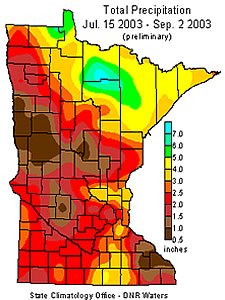|
Audio
Photos
More from MPR
Resources
Your Voice
|
Pawlenty to ask for federal aid for farmers; DFLers want state relief package too
September 5, 2003
Gov. Pawlenty said Friday that the state will seek a federal disaster declaration because of drought conditions. He says it appears about 50 of the state's 87 counties qualify for disaster assistance because of the late-summer drought. Some House Democrats say the governor should also start putting together a state disaster relief package.
St. Paul, Minn. — The governor said on his weekly radio show that the state will seek the federal declaration in the next few days. That would allow farmers in eligible counties to qualify for low-interest loans with a rate of 3.75 percent. Pawlenty says damage to Minnesota crops is already estimated at more than $1 billion. He says he's hopeful the federal government will declare Minnesota a disaster area.
"Through the declaration and the loans and, hopefully, the insurance that's available for many of our farmers, at least we can soften the impacts of this otherwise very difficult situation for our Minnesota farmers," he said.
|
Agriculture still accounts for about 20 percent of the jobs in this state. So whenever agriculture gets hit, we feel a ripple all across the state.
- Rep. Al Juhnke, DFL-Willmar |
State Agriculture Commissioner Gene Hugoson says most of Minnesota's crops are covered by crop insurance. But he says that won't pay for all of the damage.
"Eighty-five percent of our corn acres are covered, 90 percent of wheat and soybean acres of covered, but you need to understand, though, that that's not going to make these farmers whole. That it just kicks in at a certain point, and partially reimburses them for their losses," Hugoson said.
Hugoson says it will be at least a month before the U.S. Agriculture Department decides whether to approve Minnesota's disaster declaration request.
Rural House Democrats, who had called on Pawlenty to seek the declaration, were pleased with the news. Rep. Al Juhnke, DFL-Willmar, says disaster aid is crucial because the impact of the drought will be felt throughout the state.
"Realize that agriculture still accounts for about 20 percent of the jobs in this state. So whenever agriculture gets hit, we feel a ripple all across the state, whether you're a hardware store on Main Street Minnesota, a car dealer or implement dealer out here, or whether you're a computer programmer or grain trader or someone else down in the Twin Cities; there's a lot of ag-related jobs, and when that industry suffers, the whole state economy suffers," Juhnke said.
The economic ripples could affect the state's precarious budget situation. Lawmakers just finished erasing a projected $4.5 billion budget deficit, and could find themselves dealing with more red ink when they return to the Capitol in 2004.
Despite the state's fiscal problems, Juhnke and other House Democrats say Pawlenty should begin developing an ag disaster response plan. Juhnke says state resources are tight, but state officials should explore ways to supplement any federal aid.
"Obviously, there's ways we can look to enhance revenue and that's another discussion, but certainly we did leave some money on the bottom line, if you remember last year, a few hundred million dollars in fact to preserve our bond rating," he said.
The governor's communications director, Dan Wolter, says any talk of state disaster aid is premature. He says the state is still assessing the extent of the damage. State officials will have a better picture next week, when a nationwide crop report from the U.S.D.A. is released. A similar report a month ago predicted a bumper crop for Minnesota, including a record soybean crop. Now, the picture is likely to be gloomy in many parts of the state, particularly in southeast, west-central and central Minnesota.
Benton County extension educator Dan Martens says for many farmers in central Minnesota, this is the third year of poor crops. "They're pretty good at taking a one-year challenge and kind of dealing with it, figuring out a way to make the best of it, but when you get hit time after time after time, then eventually it starts to get to be really hard to continue to make up for those losses."
Martens says there's a wide variety of crop conditions across central Minnesota. He says some fields are still green, and any rain would help right now. Others are already brown and dried up, and Martens says it's too late for rain to save them. He says conditions are more variable than during the last big drought in 1988.
|
News Headlines
|
Related Subjects
|

